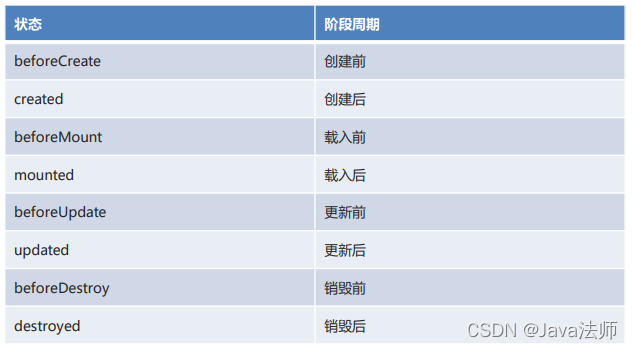自定义组件:
Element 组件其实就是自定义的标签。例如
<el-button>就是对<button>的封装。
本质上,组件是带有一个名字且可复用的 Vue 实例,完全可以自己定义。
定义格式:
Vue.component(组件名称, {props:组件的属性,data: 组件的数据函数,template: 组件解析的标签模板
})
演示:
<!DOCTYPE html>
<html lang="en">
<head><meta charset="UTF-8"><meta name="viewport" content="width=device-width, initial-scale=1.0"><title>自定义组件</title><link rel="stylesheet" href="../element-ui/lib/theme-chalk/index.css"><script src="vue.js"></script><script src="../element-ui/lib/index.js"></script></head>
<body><div id="div"><my-button>自定义按钮</my-button>
</div>
</body>
<script>Vue.component("my-button", {// 属性props: ["style"],// 数据函数data: function () {return {msg: "我的按钮"}},// 解析标签模板template: "<button style='color: #5fb1f3'>{{msg}}</button>"});new Vue({el: "#div"});
</script>
</html>
Vue生命周期:

生命周期的八个阶段:

演示:
<!DOCTYPE html>
<html lang="en">
<head><meta charset="UTF-8"><meta name="viewport" content="width=device-width, initial-scale=1.0"><title>生命周期</title><script src="vue.js"></script>
</head>
<body>
<div id="app">{{message}}
</div>
</body>
<script>let vm = new Vue({el: '#app',data: {message: 'Vue的生命周期'},beforeCreate: function() {console.group('------beforeCreate创建前状态------');console.log("%c%s", "color:red", "el : " + this.$el); //undefinedconsole.log("%c%s", "color:red", "data : " + this.$data); //undefinedconsole.log("%c%s", "color:red", "message: " + this.message);//undefined},created: function() {console.group('------created创建完毕状态------');console.log("%c%s", "color:red", "el : " + this.$el); //undefinedconsole.log("%c%s", "color:red", "data : " + this.$data); //已被初始化console.log("%c%s", "color:red", "message: " + this.message); //已被初始化},beforeMount: function() {console.group('------beforeMount挂载前状态------');console.log("%c%s", "color:red", "el : " + (this.$el)); //已被初始化console.log(this.$el);console.log("%c%s", "color:red", "data : " + this.$data); //已被初始化console.log("%c%s", "color:red", "message: " + this.message); //已被初始化},mounted: function() {console.group('------mounted 挂载结束状态------');console.log("%c%s", "color:red", "el : " + this.$el); //已被初始化console.log(this.$el);console.log("%c%s", "color:red", "data : " + this.$data); //已被初始化console.log("%c%s", "color:red", "message: " + this.message); //已被初始化},beforeUpdate: function() {console.group('beforeUpdate 更新前状态===============》');let dom = document.getElementById("app").innerHTML;console.log(dom);console.log("%c%s", "color:red", "el : " + this.$el);console.log(this.$el);console.log("%c%s", "color:red", "data : " + this.$data);console.log("%c%s", "color:red", "message: " + this.message);},updated: function() {console.group('updated 更新完成状态===============》');let dom = document.getElementById("app").innerHTML;console.log(dom);console.log("%c%s", "color:red", "el : " + this.$el);console.log(this.$el);console.log("%c%s", "color:red", "data : " + this.$data);console.log("%c%s", "color:red", "message: " + this.message);},beforeDestroy: function() {console.group('beforeDestroy 销毁前状态===============》');console.log("%c%s", "color:red", "el : " + this.$el);console.log(this.$el);console.log("%c%s", "color:red", "data : " + this.$data);console.log("%c%s", "color:red", "message: " + this.message);},destroyed: function() {console.group('destroyed 销毁完成状态===============》');console.log("%c%s", "color:red", "el : " + this.$el);console.log(this.$el);console.log("%c%s", "color:red", "data : " + this.$data);console.log("%c%s", "color:red", "message: " + this.message);}});// 销毁Vue对象//vm.$destroy();//vm.message = "hehe"; // 销毁后 Vue 实例会解绑所有内容// 设置data中message数据值vm.message = "good...";
</script>
</html>
Vue异步:
在Vue中发送异步请求,本质上还是AJAX。可以使用axios这个插件来简化操作!
使用步骤:
- 引入axios核心js文件。
- 调用axios对象的方法来发起异步请求。
- 调用axios对象的方法来处理响应的数据。
axios常用方法:

演示:
<!DOCTYPE html>
<html lang="en">
<head><meta charset="UTF-8"><title>异步操作</title><script src="js/axios-0.18.0.js"></script><script src="js/vue.js"></script></head>
<body>
<div id="div">{{name}}<button @click="send()">发起请求</button>
</div>
</body>
<script>new Vue({el: "#div",data: {name: "张三"},methods: {send() {// GET方式请求// axios.get("testServlet?name=" + this.name)// .then(resp => {// alert(resp.data);// })// .catch(error => {// alert(error);// })// POST方式请求axios.post("testServlet", "name=" + this.name).then(resp => {alert(resp.data);}).catch(error => {alert(error);})}}});
</script>
</html>
package com.example.demo1;import javax.servlet.ServletException;
import javax.servlet.annotation.WebServlet;
import javax.servlet.http.HttpServlet;
import javax.servlet.http.HttpServletRequest;
import javax.servlet.http.HttpServletResponse;
import java.io.IOException;
/*** @author itzhuzhu*/
@WebServlet("/testServlet")
public class TestServlet extends HttpServlet {@Overrideprotected void doGet(HttpServletRequest req, HttpServletResponse resp) throws ServletException, IOException {//设置请求和响应的编码req.setCharacterEncoding("UTF-8");resp.setContentType("text/html;charset=UTF-8");//获取请求参数String name = req.getParameter("name");System.out.println(name);//响应客户端resp.getWriter().write("请求成功");}@Overrideprotected void doPost(HttpServletRequest req, HttpServletResponse resp) throws ServletException, IOException {this.doGet(req,resp);}
}

)



:直接缓冲区与非直接缓冲区)





)







